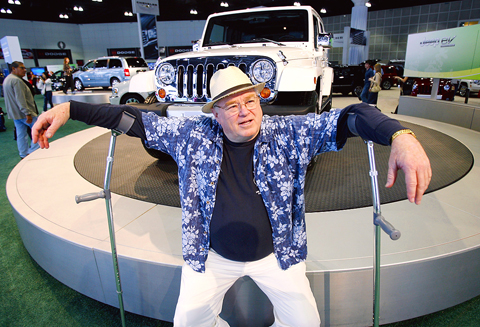The crowds at the Los Angeles Auto Show are a reluctant bunch this year. Anxious about the economy, the future of the Detroit Three automakers and the unpredictability of gas prices, few people said they had any intention of buying a new car anytime soon.
Those who did express interest in buying said they were either downsizing or looking for something with top-notch gas mileage.
Nearly all had major reservations about a bailout of the US auto industry.

PHOTO: AP
Small-business owner Greg Mohr, 50, said that under normal circumstances, he would be looking for a new car. He recently dumped his Lexus sport utility vehicle, leaving his four-person family with just a Volkswagen Beetle.
US auto sales have fallen about 14 percent in the first 10 months of the year. They plunged 32 percent last month to the lowest rate in more than 25 years and show no signs of significant improvement anytime soon.
“Anytime you start talking about recession, people will scale back their purchasing, which they have,” said Lincoln Merrihew, auto analyst with the market research firm TNS. “A car is something that’s fairly easy to postpone.”
The crowds at the auto show, which opened to the public on Friday at the Los Angeles Convention Center after two days of media previews, reflected those worries. Art Sorensen, a 32-year-old landscape designer, said he was in the market for a vehicle, but business is slow now that California’s construction boom has quieted. If he buys anything, it won’t be at least until next summer, and whatever it is will have to be super fuel-efficient, he said.
“This is the car I came to see,” Sorensen said, pointing to Honda Motor Co’s Insight hybrid, which the Japanese automaker expects to challenge the Toyota Prius when it goes on sale next year. “I’m kind of like, do I go the diesel route, or do I go the hybrid route? Obviously both are a big step in the right direction from where I’m at right now.”
Although fuel prices are now less than half what they were when the national average surpassed US$4 a gallon (US$1.06 a liter) in July, many still said their next car purchase would be a vehicle that gets good gas mileage.
The US automakers’ presence seemed to reflect their dire state.
Ford Motor Co has the most impressive spread — indeed, it is the only one with enough cash and credit to survive through next year. The Dearborn, Michigan, company showed off redesigned Ford Fusion and Mercury Milan sedans unveiled on Wednesday, including hybrid models that can go up to 1,125km on one tank of gas.
It also sported a giant Mustang display and a miniature Fusion racecar track.
The mood was more subdued at General Motors Corp. Two weeks ago, the automaker canceled the unveilings it had planned for the show, but its Chevrolet Volt — the extended-range electric vehicle that holds many of the company’s hopes for a turnaround — attracted a modest crowd.
Chrysler LLC’s area, however, was almost funereal. Chrysler also abstained from any vehicle debuts, though it did showcase the three electric prototypes — a Dodge, a Jeep and a Town & Country minivan — that it unveiled in September.
But the crowds were thin. In contrast to the concert-like lighting and sound at Nissan Motor Co’s adjacent space, the convention center’s dim fluorescent lights were all that lit Chrysler’s vehicles. On Friday afternoon, retirees Greg and Pinkie Stanley were the only ones paying attention to a Chrysler rep’s sales pitch for the Town & Country EV.
“I was just being polite,” said Greg Stanley, 71, as the couple walked to the next exhibit.
Some visitors, like Ron Myers, 65, were more sympathetic to the Detroit Three’s troubles. Myers, a longtime truck owner, said he was in the market for a GMC Sierra 1500 pickup. He said he had a long history of owning Ford and GM trucks.
“They never made better cars,” the retired firefighter said of GM.
Ask him about the government bailout, though, and his opinions get complicated. He said he’d like to see GM get assistance, but it has to find a way to reduce its labor costs.
“I’m union, but they have to be competitive,” he said. “It’s a global market.”

The Central Weather Administration (CWA) yesterday said it expected to issue a sea warning for Typhoon Fung-Wong tomorrow, which it said would possibly make landfall near central Taiwan. As of 2am yesterday, Fung-Wong was about 1,760km southeast of Oluanpi (鵝鑾鼻), Taiwan’s southernmost point, moving west-northwest at 26kph. It is forecast to reach Luzon in the northern Philippines by tomorrow, the CWA said. After entering the South China Sea, Typhoon Fung-Wong is likely to turn northward toward Taiwan, CWA forecaster Chang Chun-yao (張峻堯) said, adding that it would likely make landfall near central Taiwan. The CWA expects to issue a land

Taiwan’s exports soared to an all-time high of US$61.8 billion last month, surging 49.7 percent from a year earlier, as the global frenzy for artificial intelligence (AI) applications and new consumer electronics powered shipments of high-tech goods, the Ministry of Finance said yesterday. It was the first time exports had exceeded the US$60 billion mark, fueled by the global boom in AI development that has significantly boosted Taiwanese companies across the international supply chain, Department of Statistics Director-General Beatrice Tsai (蔡美娜) told a media briefing. “There is a consensus among major AI players that the upcycle is still in its early stage,”

The Central Weather Administration (CWA) yesterday said it is expected to issue a sea warning for Typhoon Fung-wong this afternoon and a land warning tomorrow. As of 1pm, the storm was about 1,070km southeast of Oluanpi (鵝鑾鼻), Taiwan’s southernmost point, and was moving west-northwest at 28 to 32kph, according to CWA data. The storm had a radius of 250km, with maximum sustained winds of 173kph and gusts reaching 209kph, the CWA added. The storm is forecast to pass near Luzon in the Philippines before entering the South China Sea and potentially turning northward toward Taiwan, the CWA said. CWA forecaster Chang Chun-yao (張峻堯) said

Japanese Prime Minister Sanae Takaichi yesterday said that China using armed force against Taiwan could constitute a "survival-threatening situation" for Japan, allowing the country to mobilize the Japanese armed forces under its security laws. Takaichi made the remarks during a parliamentary session while responding to a question about whether a "Taiwan contingency" involving a Chinese naval blockade would qualify as a "survival-threatening situation" for Japan, according to a report by Japan’s Asahi Shimbun. "If warships are used and other armed actions are involved, I believe this could constitute a survival-threatening situation," Takaichi was quoted as saying in the report. Under Japan’s security legislation,